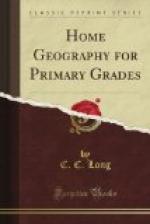We were soon outside the city, walking along the road. We passed a village, and went through fields and woods. By and by we could see the land before us rising higher and higher. We saw no longer such beautiful farms and gardens as we had passed.
[Illustration: “AS WE WENT UP THE SLOPE.”]
In a little while we reached the foot of the hill and began to ascend. As we went up the slope, we came to steep, rugged places that were hard to climb, where we needed our sticks. The trees were smaller, and there were many bushes. There were large rocks, too, in the sides of the hill. At the foot, the weather was quite warm, but it grew cooler and cooler the higher we went.
[Illustration: “WE COULD SEE THE CITY WITH ITS LITTLE STRAIGHT STREETS.”]
“On the summit at last!” cried Fred, as we reached the top.
From where we stood, we could see the city with its little straight streets, that look so wide when we walk on them. We could see the house-tops, too, and the church steeples. Then father showed us the village we passed; and the woods we went through. But the trees looked like bushes, and some men at the foot of the hill looked no larger than the baby.
Down the mountain, a little way, we found a spring where the water was clear and cool. Here we sat down on a rock, and ate the lunch we had brought. While we rested, we watched the little rill that flowed from the spring—
“Blue in the shadow,
Silver in the sun.”
Down the hill, it was larger, and we saw other rills flowing into it. When it reached the valley, it was much larger; and farther down, father said, boats could sail on it.
[Illustration: “IN THE VALLEY LAY A LARGE SHEET OF STILL WATER.”]
Before us, in the valley, lay a large sheet of still water.
“Oh, how pretty!” exclaimed I.
“Yes, that is a lake,” said father. “How beautiful it looks as the sunlight plays on its smooth surface! It reflects in its clear water the sky and the trees around it.”
“I can see an island in the lake,” said Fred. “Vessels are sailing all round it.”
“Are all islands small, like that?” he asked.
“Oh, no!” said father. “Some islands are hundreds of miles round, and have many people living upon them.”
Fred then pointed to a piece of land extending out into the water, and asked whether that, too, was an island.
“No,” replied father, “that is a peninsula. It is land almost surrounded by water. And the narrow neck which joins the peninsula to the mainland is called an isthmus.
“You see the bend in the land, with the water from the lake running in?” asked father.
“Yes,” said Fred.
“That is called a bay. Around every ocean, which is a much larger body of water, there are many such bays.
“The narrow strip of water, which a boat is just entering, is called a strait. The strait separates the island from the mainland.”




